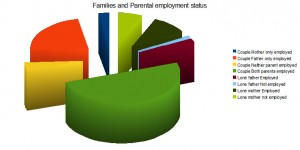
This week there was an article in the NY Times (in the fashion and style section, but that’s another story) asking whether Dads are taking over on the home front. It was prompted by some census statistics that there are now 176,000 dads in the US who have left the workforce entirely to raise children. That made me look at our own data, here in Australia, to see how we compare.
And Channel 9 has a new show called Househusbands, to cash in on the new trend.
So how do our stay-at-home dads compare?
According to the 2009-10 Family Characteristics Survey, in Australia, there were 2,290,000 couple families with dependent children (with 4,438,000 dependent children). There are another 471,000 lone mother families, and 84,000 lone father families. That’s a total of 2,845,000 families with 5,370,000 dependent children.
The traditional view of the stay-at-home dad is the dad who stays at home looking after the kids while the mother works. In 2009-10, around 11% of all stay at home parents with dependent children were stay at home dads (whether in single parent or dual parent families). And 4% of all couple families with dependent children have a stay at home dad. That’s more than I expected it to be, and certainly a lot more than the US proportionately (not counting the households with two non working parents, there are 106,000 dads with dependent children in Australia who aren’t working).
We’re not Sweden yet, though
In Australia, both parents (with permanent jobs) are eligible for unpaid parental leave of a total of 12 months, which they can share between them. So dads can start being the primary carer from the beginning if they choose. And there is a paid parental leave scheme for primary carers who were working before the child was born, and who earned less than $150,000 in that year. The parent who takes both forms of leave, though, is overwhelmingly the mother. It is often a rational decision to disrupt one persons job, rather than two. And that tends to lead to the mother continuing as the primary carer even if she works part or full time.
In Sweden, this dynamic has been changed by a rule that two months of the (paid) parental leave available can only be taken by the father, so the vast majority of Swedish fathers have had some time as the primary carer for their children. I imagine the Swedish stay at home dad percentage is still a bit higher than ours.

1 Comment
Comments are closed.